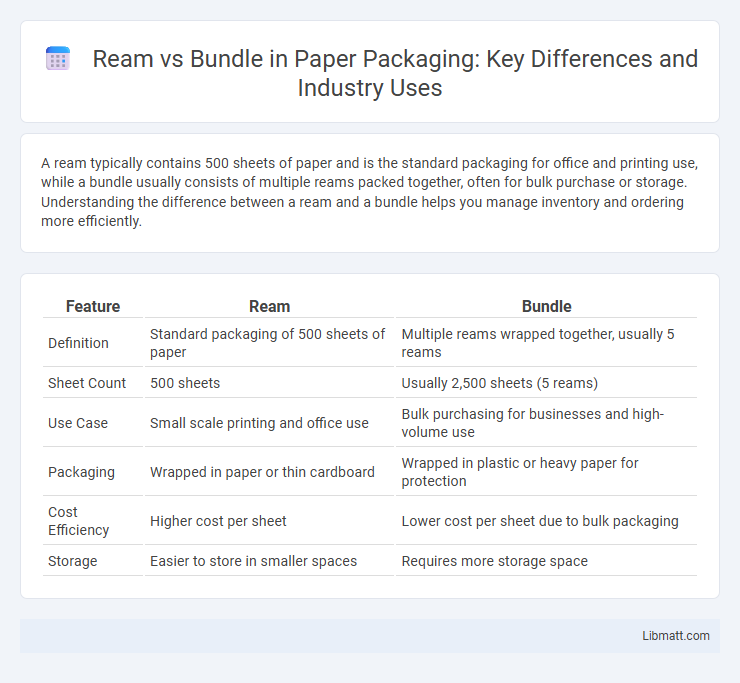A ream typically contains 500 sheets of paper and is the standard packaging for office and printing use, while a bundle usually consists of multiple reams packed together, often for bulk purchase or storage. Understanding the difference between a ream and a bundle helps you manage inventory and ordering more efficiently.
Table of Comparison
| Feature | Ream | Bundle |
|---|---|---|
| Definition | Standard packaging of 500 sheets of paper | Multiple reams wrapped together, usually 5 reams |
| Sheet Count | 500 sheets | Usually 2,500 sheets (5 reams) |
| Use Case | Small scale printing and office use | Bulk purchasing for businesses and high-volume use |
| Packaging | Wrapped in paper or thin cardboard | Wrapped in plastic or heavy paper for protection |
| Cost Efficiency | Higher cost per sheet | Lower cost per sheet due to bulk packaging |
| Storage | Easier to store in smaller spaces | Requires more storage space |
Introduction to Paper Packaging: Ream vs Bundle
A ream in paper packaging typically contains 500 sheets, offering a standardized measurement for quality control and inventory management. A bundle usually holds multiple reams, often 5, making it ideal for bulk storage and transport efficiency. Understanding the difference between a ream and a bundle helps optimize your paper usage and streamline packaging solutions.
Defining a Ream in Paper Packaging
A ream in paper packaging refers to a standardized quantity of paper sheets, typically consisting of 500 sheets per ream. This unit is essential for measuring bulk paper orders and facilitates consistent inventory management across industries. Understanding the distinction between a ream and a bundle, which often includes multiple reams, is crucial for accurate procurement and cost calculation.
What Constitutes a Bundle in Paper Packaging
A bundle in paper packaging typically consists of multiple reams tightly wrapped together to facilitate easier handling, storage, and transportation. Each ream generally contains 500 sheets of paper, while a bundle may contain 5 or more reams, depending on the manufacturer's specifications. Your choice between a ream and a bundle depends on the volume of paper needed and your storage capacity.
Key Differences Between Ream and Bundle
A ream typically contains 500 sheets of paper and is used for standardized packaging and distribution, whereas a bundle varies in size but generally holds multiple reams or a smaller, loosely packed quantity of sheets intended for bulk handling. Reams are precisely counted and often wrapped in branded, protective paper or plastic, ensuring consistent weight and measurement, while bundles may lack uniform packaging and are used primarily for transport or resale in larger volumes. The primary difference lies in quantity standardization and packaging form, with reams serving as the fundamental retail unit and bundles catering to bulk supply chains.
Common Uses for Reams in Industry
Reams of paper, typically consisting of 500 sheets, are widely used in industries such as printing, publishing, and office supplies for consistent paper quantity and quality management. Their standardized size facilitates inventory control and efficient distribution across commercial printers and corporate environments. Common applications include document printing, promotional material production, and bulk paper sales, where uniformity and ease of handling are critical.
Typical Applications of Bundles in Packaging
Bundles in paper packaging are commonly used for consolidating multiple consumer products like newspapers, magazines, and thin board sheets to enhance handling efficiency and reduce damage during transportation. These bundles provide a cost-effective way to organize and secure smaller units, facilitating easier storage and inventory management. You benefit from increased operational efficiency and improved product protection when using bundles in your packaging strategy.
Benefits of Using Reams for Paper Storage
Reams offer precise quantities of paper, typically 500 sheets, ensuring consistent inventory management and simplified ordering processes. This uniformity reduces storage space by enabling compact stacking compared to irregular bundles, facilitating efficient warehouse organization. Reams also maintain paper quality by providing protective wrapping that minimizes exposure to dust and moisture during storage.
Advantages of Bundles for Bulk Paper Handling
Bundles offer increased convenience for bulk paper handling by providing easier transportation and storage compared to reams. Their compact size reduces packaging waste and enhances stackability, optimizing space in warehouses and during shipping. You benefit from streamlined inventory management and reduced labor costs due to the efficient handling of bundles.
Selecting the Right Packaging: Ream or Bundle?
Choosing between ream and bundle packaging depends on your paper storage and handling needs. Reams, typically containing 500 sheets wrapped individually, offer protection from moisture and are ideal for controlled environments. Bundles, usually comprising multiple reams wrapped loosely, are suited for bulk transport but may require additional care to prevent damage during shipping.
Sustainability Considerations in Ream and Bundle Packaging
Ream packaging typically uses more paper and ink for labeling, which can increase material waste and environmental impact compared to bundle packaging that often utilizes minimal wrapping and fewer printed elements. Bundles can be more sustainable by reducing excess packaging materials and enabling easier recycling due to simpler designs and less adhesive use. Your choice between ream and bundle packaging should consider the balance between product protection and reducing carbon footprint for eco-friendly paper packaging solutions.
Ream vs bundle (paper packaging) Infographic

 libmatt.com
libmatt.com